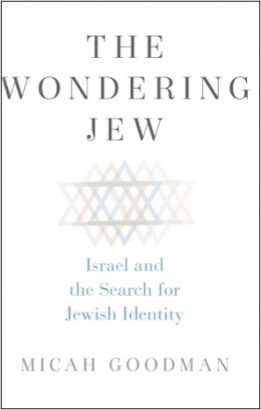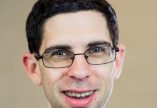In the spring and summer of 2017, Micah Goodman caused something of a publishing sensation with Milkud 67, an incisive and powerfully-argued contribution to the seemingly-endless Left-Right debate on the Israeli-Palestinian conflict. A year later, when the English translation (Catch-67) came out, it was a ‘must-read’ amongst the relevant Anglosphere commentariat – see Goodman featured in a Fathom Forum. Tucked away in the Acknowledgements at the back was the promise that Catch-67 was the first of two, and that the sequel would focus on Israel’s secular/religious divide. Appearing in 2019 in Hebrew, it has now been translated and published in English as The Wondering Jew. The two books are similar in many ways, from their near-identical lengths, their helpful and exhaustive notes, to the similar style of argumentation and tone of voice. But for me, the books diverged in one important respect: whereas I found Catch-67’s destination more interesting than its journey, with The Wondering Jew, I felt the reverse.
Goodman’s basic project is clear. He sees an Israeli Jewish secularism that is lacking in rootedness, is anti-traditional and whose fear of Jewish religious coercion prevents it from embracing the richness of Jewish text and the warmth of cohesive Jewish community. And he sees an Israeli Jewish (Orthodox) religiosity that is lacking in openness, is at times unequal and intolerant, and whose fear of intellectual challenge prevents it from engaging meaningfully in discourse with the wisdom of Western thought, as well as requiring its adherents to check their rationality at the door of the beit midrash (place of learning). Goodman, of course, is a centrist, a moderate, a ‘both/and’ Jew. He aims to intellectually neutralise the more radical forms of secularism and of religiosity, and to show that there may be a better, middle path. (Goodman’s philosophical work has included a deep interest in Maimonides, whose influence is clear. The medieval thinker’s concept of the ’Golden Mean’, derived from Aristotle, is essentially Goodman’s frame of reference throughout the book.)
Within secularism, he sees Ahad Ha’am as representing an original Zionist secularism that was rooted in tradition, respectful of the past and comfortable engaging with Jewish text and culture. In opposition, he identifies a rebellious secularism with Micha Josef Berdyczewski, who saw Zionism as a revolt against God, the rabbis and the weakness of the (Diasporic) past. In Goodman’s compelling telling, Berdyczewski won out but Ahad Ha’am’s ideas never quite went silent, and in the recent Israeli phenomenon of Hitchadshut Yehudit (Jewish Renewal), there are clear signs of (one-time? semi-? demi-?) secular Jews re-engaging with Judaism and grappling with Jewish ideals, but on their own terms. Goodman then offers two other possible foundations out of which a Jewishly-engaged secularism might be formed: A. D. Gordon’s mystical approach; and Hayim Nachman Bialik’s attempt to embrace the halacha as a way to influence, rather than control, Jewish life. Through further, quite fascinating, arguments around atheism, the nature of Jewish continuity and adopting the dialogical approach of Amos Oz and Fania Oz-Salzburger in their book Jews and Words, Goodman concludes that secularism can be a totally legitimate expression of the Jewish tradition, but that many secular Israeli Jews lack the basic knowledge, familiarity and understanding with the Jewish textual library to properly access the Jewish conversation.
Turning then to Religious Zionism, Goodman sees its challenges not so much through the prism of the debates amongst its founders but as a fracturing of Orthodox Judaism along the dividing lines of answers to some fundamental questions: What is ‘redemption’, and how should it be brought about? Does a proper understanding of Orthodox Judaism require one to be a Zionist, or does a deep commitment to Zionism compel Orthodox Jewish belief and practice? If the truths (or Truth) of Orthodox Judaism is so obvious, why is secular Zionism still alive and well, and indeed willing to uproot Religious Zionists (and others) from settlements in Gaza and the West Bank? What is the relationship of Religious Zionism to exilic Judaism, i.e. Judaism outside the State of Israel? (In one brilliant passage, Goodman argues that Judaism requires Jews to feel strong when they were in fact weak [i.e. in exile], but also that Judaism requires Jews to feel weak when they are in fact strong [i.e. sovereign].) What fundamentally is the purpose of Religious Zionism?
Goodman clearly has a concern that Orthodox Judaism has become too rigid and offers an implied critique of its lack of engagement with issues of social justice. He finishes up by exploring Sephardi/Mizrahi traditionalism, which for him offers something of a possible path forward. Because, in Goodman’s telling, the Jewish encounter with modernity was softer, more gradual and less threatening in Arab/Muslim-majority contexts than in European (Christian) Ashkenaz, the Jewish approach that emerged was less radical, less rebellious and less conducive to damaging binaries. Many Sephardi/Mizrahi Jews feel respect for halacha and a deep reverence for the rabbis, but nonetheless do not feel legalistically bound by Jewish law nor unwaveringly obligated to do whatever their religious leaders might say. Goodman summarises this by saying that they are faithful, rather than obedient, to the tradition. (Matti Friedman, in his brilliant 2014 Mosaic Magazine essay Mizrahi Nation, says that: ‘Tradition is not something you [ie a Sephardi/Mizrahi Jew] must take or leave, but something in which you live to the best of your ability in different ways at different times.’ That whole essay is worth reading alongside this section of Goodman’s book, with each adding context and insight to the other.)
All of this should lead to a way forward, a new Israeli Jewish synthesis, and in the last section this is what is promised. This was where I was left disappointed. Goodman lauds the approach of his own institution, Ein Prat, and frowns upon the fears that ‘radical secular’ Jews have about more open-minded members of their tribe engaging with Jewish text and conversation and that ‘radical religious’ Jews have about more open-minded members of their tribe engaging with Western thought and critical, analytical discourse. And then the book, rather abruptly, ends, except for a curious afterword about the perils of our modern addiction to our smartphones and the paradise of a digital detox Shabbat.
Goodman’s thinking is original and daring, and his exposition clear and concise. The book is buzzing with eye-opening insights and satisfying turns of phrase (aided, no doubt by Eylon Levy’s crisp and eminently readable translation). When Goodman explicates the dispute between Beit Hillel and Beit Shammai, or Buber’s distinction between religion and religiosity, one cannot help but be carried away on an intellectual magic carpet ride. It’s a shame, though, that when the train finally gets to the station, the whole ends up being less than the sum of its parts – because those parts are very much worth a look. The premises of Goodman’s argument are very satisfying, even if the conclusion lacks.



































